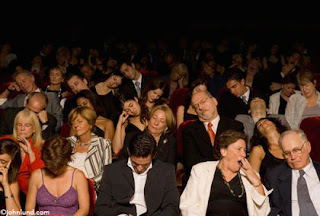I just got back from the Society for American Archaeology meetings in St. Louis
- Read your paper from a prepared text. This will almost always result in a worse presentation than if you talk from notes, or talk from your slides. This is an excellent way to give a boring talk. But it is not fool-proof; sometimes reading produces a good presentation.
- Go over the time limit. This makes the session chair mad, it shows a lack of respect for the audience and other presenters, and it makes you look less professional. Maybe this is what you want. If so, read on…..
- If you want to go over the time limit, here are some good ways to do it:
- Read your paper from a prepared text. Then when you have misjudged the timing (this happens in most cases), and your allotted time runs out, you still aren’t done! The best material is in the conclusions, right?, and so you can’t just skip them. Go on and forge ahead to gain all the benefits of running overtime.
- Stop to explain a slide. If you have planned your talk (whether to read or talk from notes), and in the process you take time out to explain a slide, I guarantee you will not finish within the time limit. Yes, this is a money-back guarantee. Try it sometime and let me know if I am right or wrong.
- Don’t bother to look at the clock or your watch during your talk.

- Don’t waste time practicing your talk ahead of time.
- Use a pointer to show something on screen (please don’t use the simple tools of powerpoint to emphasize sites or places or points with arrows, circles, etc.). Much better to wave your pointer (with an unstable hand) in the general direction and hope the audience can find the thing you are talking about, while wasting time.
- Well, perhaps you are young and nervous and insecure and feel that something will go seriously wrong if you don’t read your paper. That is probably not the case, but if you feel this way, here is a way to make sure your presentation is bad: Write the text using the style of discourse you would use in writing a journal article. That almost guarantees that your talk will be stiff and boring and difficult to follow. Don’t write it out in the style of verbal discourse, and whatever you do don't be informal or clear; that might produce a good presentation and that is not our goal here. Postmodern obfuscatory prose can help you underachieve.
- Here are some tips for making sure your slides are bad:
- Have long paragraphs of text in the slide.
- Use small font (or odd color schemes) so people can’t read the text easily.
- Use complicated charts and graphs that can’t be comprehended quickly and easily. A table that fills the screen with numbers is a great way to put the audience to sleep.
- Use a pointer to show the audience something that is painfully obvious on the slide. Needless repetition is good here, both for making you look unprofessional and for putting time on the clock to help you run over the limit.

- Insult your audience! (this should be #6, sorry) If you don't think the tips listed above will be sufficiently damaging to your talk and reputation, you can step it up a notch and insult the intelligence of your listeners. One of my favorite tricks is to put a bunch of text up on the screen, and then read it out loud, verbatim. That insults me every time.
If you follow some of these tips, you will be sure to give a low-quality presentation at your next professional conference.

No comments:
Post a Comment